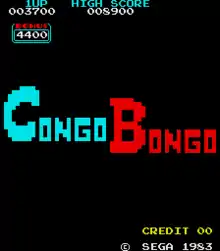Congo Bongo
Congo Bongo (コンゴボンゴ, Kongo Bongo), also known as Tip Top (ティップタップ, Tippu Tappu), is an isometric platform arcade game released by Sega in 1983. Congo Bongo's objectives and gameplay are similar to that of Donkey Kong, but levels are viewed in an isometric perspective that was introduced in Sega's Zaxxon.
| Congo Bongo | |
|---|---|
 | |
| Developer(s) | Sega |
| Publisher(s) | Sega |
| Platform(s) | Arcade, Apple II, Atari 2600, Atari 5200, Atari 8-bit, Commodore 64, ColecoVision, Intellivision, MSX, IBM PC, SG-1000, TI-99/4A, VIC-20 |
| Release | |
| Genre(s) | Platform |
| Mode(s) | Up to 2 players, alternating turns |
The game includes a ROM that contains a message indicating it was likely coded at least in part by the company Ikegami Tsushinki.[1][2][3]
Plot
.png.webp)
A safari explorer was sleeping in the jungle when a large ape named Bongo set his tent on fire. The explorer pushes deeper into Bongo's domain to exact revenge.
Gameplay
In the first stage, the hunter must avoid coconuts thrown by Bongo and he has to climb a series of cliffs to reach the ape, while at the same time shaking off three monkeys that try to throw the hunter off the mountain.
In the second stage, the hunter must cross a swamp platform by riding on the backs of diving and swimming hippopotamuses and avoiding both poisonous snakes and scorpions.
The third stage requires the hunter to cross a plain and crouch into holes to evade the horns of charging rhinoceroses, while climbing up large flights of stairs to proceed to the next area.
In the fourth and final stage, the hunter crosses a second swamp that with lily pads, fish, and hippos, to reaach a gate of charging rhinos that are blocking the entrance to Bongo in a hot tub.
The game repeats from the first level with increased difficulty.
Ports
Congo Bongo was ported to the Apple II, SG-1000, MSX, Intellivision,[4] ColecoVision, Commodore 64 (first as a cartridge, then later to disk), VIC-20, IBM PC, Atari 2600, Atari 5200, Atari 8-bit family, and the Texas Instruments TI-99/4A.[5] Sega's ports for the Atari 2600, 5200, Atari 8-bit, Intellivision, and Commodore 64 (cartridge version) include two of the four levels from the arcade original, while the ColecoVision release is missing the "Snake Lake" level.
Reception
Time reported in 1983 that the arcade game was a commercial failure.[6]
In Japan, Game Machine listed Congo Bongo on their June 15, 1983 issue as being the fifth most-successful table arcade unit of the year.[7] Ahoy! in 1984 stated that Congo Bongo for the Commodore 64 and VIC-20 "is fraught with problems; gameplay is repetitive, frustrating, tedious, inconsistent, and at times confusing, and the music not only got on my nerves but stomped on them. Plus, the whole thing is derivative".[8] In 1984 ST. Game readers named the game the worst Atari program of 1983, even worse than the notorious E.T. the Extra-Terrestrial.[9]
Legacy
The original arcade release is included in the PlayStation Portable version of Sega Genesis Collection (as an unlockable game) and Sonic's Ultimate Genesis Collection for Xbox 360 and PlayStation 3. An enhanced remake was released for the PlayStation 2 under the Sega Ages label as a part of Sega Ages 2500 Series Vol. 23: Sega Memorial Selection.
References
- Ikegami Tsushinki
- ドンキーコング裁判についてちょこっと考えてみる Archived 2010-03-12 at the Wayback Machine Thinking a bit about Donkey Kong, accessed 2009-02-01
- It started from Pong (それは『ポン』から始まった : アーケードTVゲームの成り立ち, sore wa pon kara hajimatta: ākēdo terebi gēmu no naritachi), Masumi Akagi (赤木真澄, Akagi Masumi), Amusement Tsūshinsha (アミューズメント通信社, Amyūzumento Tsūshinsha), 2005, ISBN 4-9902512-0-2.
- Intellivision Rarity Guide
- TI-99/4A-Pedia: Congo Bongo
- According to "Video Games Go Crunch!" in TIME magazine October 17, 1983 issue, Congo Bongo was a commercial failure initially.
- "Game Machine's Best Hit Games 25 - テーブル型TVゲーム機 (Table Videos)". Game Machine (in Japanese). No. 214. Amusement Press, Inc. 15 June 1983. p. 27.
- Hallassey, Dan (March 1984). "Congo Bongo". Ahoy!. p. 60. Retrieved 27 June 2014.
- "The Best and the Rest". ST. Game. Mar–Apr 1984. p. 49. Retrieved 28 July 2014.
External links
- Congo Bongo at the Killer List of Videogames
- Congo Bongo at Phosphor Dot Fossils
